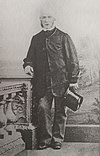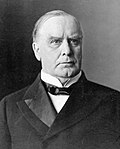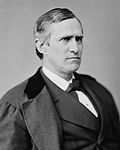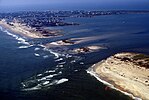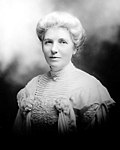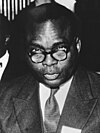Wikipedia:Today's featured article/September 2018
| << | Today's featured articles for September 2018 | >> | ||||
|---|---|---|---|---|---|---|
| Su | Mo | Tu | We | Th | Fr | Sa |
| 1 | ||||||
| 2 | 3 | 4 | 5 | 6 | 7 | 8 |
| 9 | 10 | 11 | 12 | 13 | 14 | 15 |
| 16 | 17 | 18 | 19 | 20 | 21 | 22 |
| 23 | 24 | 25 | 26 | 27 | 28 | 29 |
| 30 | ||||||
September 1
Messier 87 is a supergiant elliptical galaxy in the constellation Virgo. It has about 12,000 globular clusters—compared to the 150 to 200 orbiting the Milky Way—and a jet of energetic plasma that originates at the core and extends at least 4,900 light-years. One of the brightest radio sources in the sky, it is a popular target for both amateur and professional astronomers. The French astronomer Charles Messier discovered the galaxy in 1781, and catalogued it as a nebulous feature while searching for objects that would otherwise confuse comet hunters. About 53.5 million light-years from Earth, M87 is the second brightest galaxy within the northern Virgo Cluster. Unlike disk-shaped spiral galaxies, M87 has no distinctive dust lanes. Instead, it has an almost featureless ellipsoidal shape typical of most giant elliptical galaxies, diminishing in luminosity away from the center. It has a supermassive black hole at its core, powering an active galactic nucleus. (Full article...)
September 2
Boletus aereus, the dark cep, is a prized edible mushroom in the family Boletaceae. It is widely consumed in Spain, France, Italy, Greece, and generally throughout the Mediterranean. Described as a new species in 1789 by French mycologist Pierre Bulliard, it is closely related to several other European boletes, including B. reticulatus, B. pinophilus, and the popular B. edulis. The fungus predominantly grows near broad-leaved trees and shrubs in symbiosis with the roots, enveloping them with sheaths of fungal tissue. Quercus suber, the cork oak, is a key host. The spore-bearing mushrooms appear above ground in summer and autumn, growing a large dark brown cap, up to 30 cm (12 in) in diameter. Like other boletes, B. aereus releases its spores through pores on the underside of the cap instead of gills; this surface is whitish when young, aging to a greenish-yellow. The squat brown stalk, up to 15 cm (6 in) tall and 10 cm (4 in) thick, is partially covered with a raised network pattern. (Full article...)
September 3
The Avenue Range Station massacre was the murder of at least nine Aboriginal Tanganekald people, who were shot by white settlers on the Avenue Range pastoral station in the colony of South Australia around September 1848, during the Australian frontier wars. Those confirmed to have been killed were an old blind man, three women, two teenage girls, and three female children, including a baby. The sheep farmer James Brown (pictured) and his overseer, Eastwood, were suspected, and Brown was charged with the murder of "unknown aboriginal natives" in March 1849. The magistrate who committed him for trial said that there was "little question of the butchery or the butcher". Further investigation was ordered, but by the November 1849 sittings of the Supreme Court in the colonial capital of Adelaide, the case had been dropped. At the time there were significant restrictions on the use of evidence given by Aboriginal witnesses, especially where a verdict could involve capital punishment. (Full article...)
September 4
"Starvin' Marvin" is the eighth episode in the first season of the American animated television series South Park. It first aired on Comedy Central on November 19, 1997. A satire on the humanitarianism industry and American indifference toward impoverished countries, it was written and directed by series co-creator Trey Parker (pictured). In the episode, Cartman, Kenny, Kyle and Stan send money to an African charity hoping to get a sports watch, but are instead sent an Ethiopian child they call "Starvin' Marvin". In a Thanksgiving-themed subplot, genetically engineered turkeys attack South Park. The episode received generally positive reviews, and several commentators have described it as a classic episode. It was originally viewed by about 2.2 million households, roughly eight times Comedy Central's average viewership at the time. In addition to Starvin' Marvin, who became a popular minor character, the episode introduced Kyle's father Gerald Broflovski and Kenny's family members Stuart, Carol and Kevin McCormick. (Full article...)
September 5
The Metallurgical Laboratory at the University of Chicago in the US state of Illinois was established during World War II to research the chemistry and metallurgy of the newly discovered element plutonium, as part of the Allied Manhattan Project to build an atomic bomb. It developed chemical processes to separate plutonium, and created the first weighable sample. The lab produced the first controlled nuclear chain reaction in the Chicago Pile-1 nuclear reactor, which was constructed under the stands of the university's old football stadium, Stagg Field. Another reactor, Chicago Pile-3, the first reactor to use heavy water as a neutron moderator, was built in early 1944. The Metallurgical Laboratory also designed the X-10 Graphite Reactor at the Clinton Engineer Works in Oak Ridge, Tennessee, and the B Reactor at the Hanford Engineer Works. It became the first of the national laboratories, the Argonne National Laboratory, on 1 July 1946. (Full article...)
Part of the History of the Manhattan Project featured topic.
September 6
Babakotia, an extinct genus of sloth lemurs, lived in the northern part of Madagascar. The name comes from the Malagasy word for the indri, to which all sloth lemurs are closely related. Its morphological traits show intermediate stages between the slow-moving smaller sloth lemurs and the suspensory large sloth lemurs, and suggest a close relationship between both groups and the extinct monkey lemurs. All sloth lemurs share many traits with living sloths, demonstrating convergent evolution. Babakotia had long forearms, curved digits, and highly mobile hip and ankle joints. It shared its range with other sloth lemurs, including Palaeopropithecus ingens and Mesopropithecus dolichobrachion. It was primarily a leaf-eater, though it also ate fruit and hard seeds. It is known only from subfossil remains and may have died out shortly after the arrival of humans on the island, but not enough radiocarbon dating has been done with this genus to know for certain. (Full article...)
September 7
"Don't Stop the Music" is a song recorded by Barbadian singer Rihanna (shown performing it) for her third studio album, Good Girl Gone Bad. It was released worldwide on September 7, 2007, as the fourth single of the album. The song was written by Tawanna Dabney and StarGate; Michael Jackson also received a songwriting credit for the sampling of the line "Mama-say, mama-sa, ma-ma-ko-ssa" from his 1983 single "Wanna Be Startin' Somethin'". "Don't Stop the Music" is a dance track with hip hop rhythmic devices. The song's accolades include a Grammy Award nomination for Best Dance Recording. It reached number four on the UK Singles Chart, number three on the US Billboard Hot 100, and number one in nine countries, including Australia, France, Germany, and Switzerland. It has sold more than 3.7 million copies in the US. The singer performed "Don't Stop the Music" at the 50th Annual Grammy Awards and the NRJ Music Awards in 2008, and included it on her Good Girl Gone Bad, Last Girl on Earth, Loud and Diamonds World Tour set lists. (Full article...)
September 8
Lockdown (2008) was a professional wrestling pay-per-view (PPV) event produced by the American Total Nonstop Action Wrestling (TNA) promotion at the Tsongas Arena in Lowell, Massachusetts, on April 13. It was the fourth event in the 2008 TNA PPV schedule. Eight professional wrestling matches, including two for championships, were featured on the card. Matches took place inside a six-sided steel structure (pictured). The main event was for the TNA World Heavyweight Championship between then-champion Kurt Angle and Samoa Joe, won by Joe. Also held on the card was the 2008 Lethal Lockdown match between Team Cage and Team Tomko. Christian Cage, Matt Morgan, Kevin Nash, Rhino, and Sting of Team Cage defeated Tomko, A.J. Styles, James Storm, and Team 3D (Brother Devon and Brother Ray) of Team Tomko in the contest. The Wrestling Observer Newsletter reported 55,000 purchasers for the event. Chris Sokol of SLAM! Wrestling rated it a 6.5 out of 10. (Full article...)
September 9
The Vermont Sesquicentennial half dollar is a commemorative fifty-cent piece struck by the United States Mint in 1927. Designed by Charles Keck, its obverse depicts early Vermont leader Ira Allen, brother of Ethan Allen. The reverse design of a catamount has been criticized as irrelevant to Vermont. On January 9, 1925, U.S. Senator Frank L. Greene of Vermont introduced legislation for commemorative coins to mark the 150th anniversary of Vermont independence in 1777 and of the American victory at the Battle of Bennington the same year. His bill passed the Senate without difficulty, but the House of Representatives added two more special half dollars. The Senate agreed to the changes, and President Calvin Coolidge signed the authorizing act on February 24, 1925. The coins did not sell out; over a fourth of the issue was returned for redemption and melting. Today, they can sell for hundreds of dollars, depending on condition. (Full article...)
September 10
D. Djajakusuma (1918–1987) was an Indonesian film director and promoter of traditional art forms. During the Japanese occupation from 1943 to 1945 he was a translator and actor. In the national revolution which followed, he worked for the military's educational division and several news agencies, as well as in drama. In 1951 he joined the National Film Corporation (Perfini) at the invitation of Usmar Ismail. After his directorial debut with Embun, he released a further eleven films with the company before leaving in 1964. He then returned to traditional Indonesian theatre, including wayang. Although he continued to direct movies, most of his energies were dedicated to promoting traditional art forms and teaching cinematography. His theatrical performances attempted to modernise traditional forms. He is credited with revitalising the Betawi theatre form lenong and received numerous awards for his filmmaking, including a lifetime achievement award at the Indonesian Film Festival. (Full article...)
September 11
The Burke and Hare murders were a series of 16 killings committed over a period of about ten months in 1828 in Edinburgh, Scotland. They were undertaken by William Burke (pictured, left) and William Hare (pictured, right), who sold the corpses to Doctor Robert Knox for dissection at his anatomy lectures. Edinburgh was a leading European centre of anatomical study in the early 19th century, in a time when the demand for cadavers exceeded the legal supply. When a lodger in Hare's house died, he turned to his friend Burke for advice and they sold the body to Knox. They then began their murder spree, which was uncovered after other lodgers discovered their last victim, Margaret Docherty, and called the police. Hare provided the details of Docherty's murder and confessed to all 16 deaths. Burke was found guilty of one murder, sentenced to death and hanged. His corpse was dissected and his skeleton displayed at the Anatomical Museum of Edinburgh Medical School, where it remains. (Full article...)
September 12
Isis was a major goddess in ancient Egyptian religion. She first appeared in the Old Kingdom as one of the main characters of the Osiris myth, in which she resurrects her slain husband, the divine king Osiris, and produces his heir, Horus. She was believed to help the souls of the dead enter the afterlife, and her maternal aid was invoked in healing spells. In the Hellenistic period, her worship spread into the wider Greek world, and she took on traits of Greek deities, as the inventor of marriage and the protector of ships at sea. As Hellenistic culture was absorbed by Rome, the cult of Isis became a part of Roman religion, with distinctive festivals and initiation ceremonies. Her cult may have influenced aspects of Christianity, such as the veneration of Mary, but the evidence for this influence is ambiguous. Isis continues to appear in Western culture, particularly in esotericism and modern paganism, often as a personification of nature or the feminine aspect of divinity. (Full article...)
September 13
The construction of the Rockefeller Center complex in New York City was an urban renewal project, spearheaded by American financier John D. Rockefeller Jr. to help revitalize Midtown Manhattan. The center occupies 22 acres (8.9 ha) on one of Columbia University's former campuses, with some 17 million square feet (1.6×106 m2) of office space. All structures in the original complex were designed in the Art Deco style. Excavation of the site started in April 1931, and construction of the first buildings began that September. The first of the complex's edifices was opened in September 1932, and most of them were completed by 1935. The final three buildings in the original complex were built between 1936 and 1940. The project employed over 40,000 people and was the largest private construction project at the time. An additional building went up at 75 Rockefeller Plaza in 1947, and another at 600 Fifth Avenue was built in 1952. Four towers were built in the 1960s and 1970s. (Full article...)
September 14
William McKinley (January 29, 1843 – September 14, 1901) was the 25th President of the United States, serving from March 4, 1897, until his death. McKinley served in the Civil War and rose from private to brevet major. In 1876, he was elected to Congress, where he advocated a protective tariff, which he promised would bring prosperity. His controversial 1890 McKinley Tariff, together with a Democratic redistricting effort aimed at gerrymandering him out of office, led to his defeat in the Democratic landslide of 1890. He then served four years as Governor of Ohio. In 1896, running a front porch campaign, he defeated Democrat William Jennings Bryan, and won a rematch four years later. McKinley led the nation to victory in the Spanish–American War, raised protective tariffs to promote American industry, and maintained the nation on the gold standard in a rejection of free silver. His administration ended with his assassination in September 1901, but his presidency began a period dominated by the Republican Party. (Full article...)
September 15
The Bayern-class battleships were four super-dreadnoughts, laid down from 1913 to 1915 by the Imperial German Navy. Sachsen and Württemberg were never completed, after U-boats were found to be more valuable to the war effort. Bayern (pictured) and Baden, the last German battleships completed during World War I, were commissioned into the fleet too late to take part in the Battle of Jutland (31 May – 1 June 1916). Bayern was assigned to the naval force that drove the Imperial Russian Navy from the Gulf of Riga during Operation Albion in October 1917, though the ship was severely damaged by a mine and had to be withdrawn to Kiel for repairs. Baden replaced Friedrich der Grosse as the flagship of the High Seas Fleet, but saw no combat. Bayern and Baden were interned in Scapa Flow, Scotland, following the Armistice in November 1918; in June 1919, Bayern was scuttled along with other fleet ships at the command of Rear Admiral Ludwig von Reuter. (Full article...)
Part of the Battleships of Germany featured topic.
September 16
Thomas F. Bayard (1828–1898) was a lawyer, politician, and diplomat from Wilmington, Delaware. He served three terms as a US Senator from Delaware and made three unsuccessful bids for the Democratic nomination for President of the United States. In 1885, President Grover Cleveland appointed him Secretary of State. Bayard worked with Cleveland to promote American trade in the Pacific while avoiding the acquisition of colonies at a time when many Americans clamored for them. He worked to resolve disputes over fishing and seal-hunting rights in the waters around the Canada–United States border. After four years in private life, he returned to the diplomatic arena as Ambassador to the United Kingdom, where he continued to strive for Anglo-American friendship. This brought him into conflict with his successor at the State Department, Richard Olney, when Olney and Cleveland were demanding more aggressive diplomatic overtures in the Venezuelan crisis of 1895. (Full article...)
Part of the United States presidential election, 1880 featured topic.
September 17
WestJet Encore is a Canadian regional airline that began operations in 2013 as a subsidiary of WestJet Airlines, Ltd., the holding company for WestJet Airlines. It is headquartered in Calgary, Alberta. Originally limited to Western Canada, air service was later supplemented by routes in the eastern half of the country. Pilot bases are in Calgary and Toronto, where many WestJet Encore flights operate. Because WestJet Airlines operates only larger aircraft such as the Boeing 737, the company could not profitably serve many routes with less traffic. WestJet Encore was created to use smaller planes, allowing the company to serve these routes and to increase the frequency of flights on other routes. The airline is the fourth largest operator of the Bombardier Q400 NextGen aircraft (pictured), a variant of the Bombardier Dash 8. The airline was initially staffed with non-union employees but the pilots have since unionized. (Full article...)
September 18
Hurricane Isabel struck North Carolina on the East Coast of the United States on September 18, 2003. Forming in early September in the tropical Atlantic Ocean, the storm had moved northwestward, with peak winds of 165 mph (265 km/h). Isabel made landfall on the Outer Banks with winds of 105 mph (165 km/h), then quickly weakened over land and became extratropical over western Pennsylvania the next day. It produced moderate to heavy damage across eastern North Carolina. Storm surge and strong winds in Dare County damaged thousands of houses and created a 2,000-foot (600 m) inlet on Hatteras Island (pictured), washing out parts of North Carolina Highway 12 and isolating the village of Hatteras for two months. Across the state, up to 700,000 residents were left without power. Three deaths in North Carolina were attributed to the storm, and statewide damage was estimated at $450 million. (Full article...)
Part of the Hurricane Isabel featured topic.
September 19
Kate Sheppard (1848–1934) was the most prominent member of the women's suffrage movement in New Zealand, and is one of that nation's best-known historical figures. Born in Liverpool, England, she migrated to New Zealand with her family in 1868, joining religious and social organisations there, including the Woman's Christian Temperance Union (WCTU). In 1887 she was appointed the WCTU's National Superintendent for Franchise and Legislation. Sheppard promoted women's suffrage by organising petitions and public meetings, by writing letters to the press, and by developing contacts with politicians. She was the editor of the White Ribbon, the first woman-operated newspaper in New Zealand. Through her skilful writing and persuasive public speaking, her work culminated in the grant of the vote to women on 19 September 1893, making New Zealand the first nation to grant universal suffrage. (Full article...)
September 20
Dromaeosauroides was a theropod dinosaur that lived around 140 million years ago during the Early Cretaceous, making it one of the oldest known dromaeosaurs. In 2000 and 2008, two fossilised teeth from this genus (cast pictured) were discovered in the Jydegaard Formation in the Robbedale valley, on the island of Bornholm, Denmark, in the Baltic Sea. It is the first dinosaur reported from Denmark. After these discoveries, remains and tracks of more dinosaurs were found in several formations on Bornholm. Coprolites containing fish remains found in the Jydegaard Formation may belong to Dromaeosauroides. The teeth are curved and finely serrated. Based on a comparison with other dromaeosaur teeth, the genus is estimated to have been 2 to 3 metres (7 to 10 ft) in length, with a weight of about 40 kilograms (88 lb), a hide covered with feathers, and a large sickle claw on both feet. It lived in a coastal lagoon environment with sauropods, as evidenced by a possible titanosaur tooth. (Full article...)
September 21
Future Science Fiction and Science Fiction Stories were two American magazines published under various names between 1939 and 1943 and again from 1950 to 1960. Both publications were edited by Charles Hornig for the first few issues; Robert W. Lowndes took over in late 1941, and remained editor until the end. The initial launch of the magazines came as part of a boom in science fiction pulp magazine publishing at the end of the 1930s, but in 1943 wartime paper shortages ended their run. In the 1950s, with the market improving again, both magazines were relaunched. Lowndes set a friendly and engaging tone in the magazines, with letter columns and reader departments that interested fans. He was successful in obtaining good stories partly because he had good relationships with several well-known and emerging writers. Among the stories he published were "The Liberation of Earth" by William Tenn and "If I Forget Thee, Oh Earth" by Arthur C. Clarke. (Full article...)
September 22
Guy Burgess (1911–1963) was a British diplomat and Soviet agent, a member of the Cambridge Five spy ring that operated from the mid-1930s to the early years of the Cold War. His defection in 1951 to the Soviet Union, with his fellow-spy Donald Maclean, led to a serious breach in Anglo-American intelligence co-operation, and caused long-lasting demoralisation in Britain's foreign and diplomatic services. Born into a wealthy middle-class family, Burgess was educated at Eton College and Trinity College, Cambridge, where he embraced left-wing politics and joined the British Communist Party. He was recruited by Soviet intelligence in 1935, on the recommendation of the future double-agent Kim Philby. After working for the BBC as a producer, Burgess joined the Foreign Office in 1944 and served in several sensitive posts, including a spell as secretary to Hector McNeil, the deputy to Ernest Bevin, the Foreign Secretary. In the critical postwar period Burgess had access to information on all aspects of Britain's foreign policy, and may have passed thousands of documents to his Soviet controllers. He fled to Moscow in May 1951 and never left the Soviet Union. (Full article...)
September 23
The red-billed tropicbird is a seabird, one of three species in the family Phaethontidae. Resembling a tern, it has mostly white plumage with some black markings on the wings and back, a black mask and a red bill. Most adults have tail streamers that are about two times their body length, and generally longer in males than in females. Described by Carl Linnaeus in his 10th edition of Systema Naturae (1758), this species ranges across the Indian Ocean, the tropical Atlantic, and the eastern Pacific. Nesting takes place in loose colonies. A single egg is laid, and incubated by both sexes for about six weeks. After a chick fledges, the parents will usually stop visiting the nest and the chick will leave. Red-billed tropicbirds of all ages feed on fish and squid, catching them by diving from the air into the water. The birds sometimes follow surface-feeding predators that drive prey to the surface, where they can be seized. (Full article...)
September 24

Operation Ke was the largely successful withdrawal of Japanese forces from Guadalcanal in the Solomon Islands during World War II. All attempts by the Japanese army to recapture Henderson Field, the only airfield on the island being used by Allied aircraft, had been repulsed with heavy losses. Japanese ground forces had been reduced from 36,000 to 11,000 through starvation, disease, and battle casualties. Attempting to reinforce and resupply the ground forces on the island, Japanese naval forces were also suffering heavy losses of troops and matériel, including a submarine sunk in late January 1943 (wreckage pictured). The main withdrawal was carried out on the nights of 1, 4, and 7 February by destroyers. The Japanese evacuated 10,652 men from Guadalcanal, of whom 600 died during the withdrawal. On 9 February, Allied forces realized that the Japanese were gone and declared Guadalcanal secure, ending the six-month campaign for control of the island. (Full article...)
Part of the Guadalcanal Campaign featured topic.
September 25
Æthelbald was the King of Mercia, in what is now the Midlands of England, from 716 until he was killed in 757. He came to the throne after the death of his cousin, King Ceolred, who had driven him into exile. During his long reign, Mercia became the dominant kingdom of the Anglo-Saxons, and recovered the position of pre-eminence it had enjoyed during the strong reigns of Mercian kings Penda and Wulfhere between about 628 and 675. When Æthelbald came to the throne, both Wessex and Kent were ruled by stronger kings, but within fifteen years Æthelbald was ruling all England south of the river Humber, according to the contemporary chronicler Bede. Æthelbald was killed in 757 by his bodyguards. He was succeeded briefly by Beornred, of whom little is known. Within a year, Offa, the grandson of Æthelbald's cousin Eanwulf, had seized the throne, possibly after a brief civil war. Under Offa, Mercia entered its most prosperous and influential period. (Full article...)
September 26
US Highway 25 in the state of Michigan (US 25) was a highway that ran northeasterly from the Ohio state line near Toledo through Monroe and Detroit to Port Huron. Continuing near the foot of the Blue Water Bridge, it proceeded north and northwesterly along the Lake Huron shoreline to the tip of The Thumb in Port Austin. Created with the initial US Highway System in 1926, US 25 followed some roadways dating from the 19th and early 20th centuries, and replaced several state highway designations. The highway was extended to Port Austin in 1933. Starting in the early 1960s, segments of Interstate 75 and Interstate 94 were built, and US 25 was shifted to follow them concurrently south of Detroit to Port Huron. On September 26, 1973, the entire designation was removed from the state. The final routing of the highway is still maintained by the state under eight different designations, some unsigned. (Full article...)
Part of the US Highways in Michigan series, one of Wikipedia's featured topics.
September 27
From Russia, with Love is the fifth novel by the English author Ian Fleming to feature his fictional British Secret Service agent James Bond. Fleming wrote the story in early 1956 at his Goldeneye estate in Jamaica; at the time he thought it might be his final Bond book. The story centres on a plot by SMERSH, the Soviet counter-intelligence agency, to assassinate Bond in such a way as to discredit both him and his organisation. As bait, the Russians use a beautiful cipher clerk and the Spektor, a Soviet decoding machine. Much of the action takes place in Istanbul and on the Orient Express (pictured). The book was inspired by Fleming's visit to Turkey on behalf of The Sunday Times to report on an Interpol conference; he returned to Britain by the Orient Express. From Russia, with Love deals with the East–West tensions of the Cold War, and the decline of British power and influence after the Second World War. In 1963 it was adapted into the second film in the Bond series, starring Sean Connery. (Full article...)
September 28
Myst IV: Revelation is the fourth installment in the Myst series, developed by the French video game publisher Ubisoft. First released on September 28, 2004, it uses pre-rendered graphics and digital video, as in Myst III: Exile, but adds real-time 3D effects. The player is sent to question the sons and recover the daughter of Atrus, a man who creates links to other worlds by writing special linking books (illustration shown). Development of Revelation lasted more than three years, requiring as many as eighty Ubisoft employees. The original score was written by Exile's composer, Jack Wall. Musician Peter Gabriel lent his voice and a song to the audio. Overall, reception to the game was positive; reviewers lauded the visuals, sound, and puzzles, but some took issue with the control scheme. Revelation is the last game in the Myst series to use both pre-rendered backgrounds and full-motion video. (Full article...)
Part of the Myst series featured topic.
September 29
John de Gray (died 1214) was a medieval English Bishop of Norwich. He was employed in the service of King John even before the coronation, for which de Gray was rewarded with various ecclesiastical offices, culminating in his pro forma election to Norwich in 1200. He continued in royal service after his elevation to the episcopate, lending John money and undertaking diplomatic missions on his behalf. In 1205 John attempted to further reward de Gray by making him Archbishop of Canterbury, but a disputed election process led to de Gray's selection being quashed by Pope Innocent III in 1206. Stephen Langton was consecrated as archbishop against John's wishes, triggering a long dispute with the papacy. The pope imposed various sanctions on England and John. In 1209 de Gray became governor of Ireland for John, and spent until 1213 attempting to impose royal government there on the Anglo-Norman barons and the native Irish. He travelled to Rome to secure a papal pardon after the final settlement of the dispute with John. After the pardon, de Gray was appointed Bishop of Durham, but he died on his way back to England. (Full article...)
September 30
Jean Bolikango (1909–1982) was a Congolese educator, writer, and conservative politician. He was Deputy Prime Minister of the Republic of the Congo (now the Democratic Republic of the Congo), in September 1960 and from February to August 1962. Enjoying substantial popularity among the Bangala people, he headed the Parti de l'Unité Nationale and worked as a key opposition member in Parliament in the early 1960s. Beginning his career in the Belgian Congo as a teacher in Catholic schools, he wrote a novel and worked as a journalist before turning to politics in the late 1950s. Though he held a top communications post in the colonial administration, he became a leader in the push for independence. After the Republic of the Congo became independent in 1960, he promoted both a united Congo and strong ties with Belgium. The President of the Congo posthumously awarded Bolikango a medal in 2005 for his long career in public service. (Full article...)



